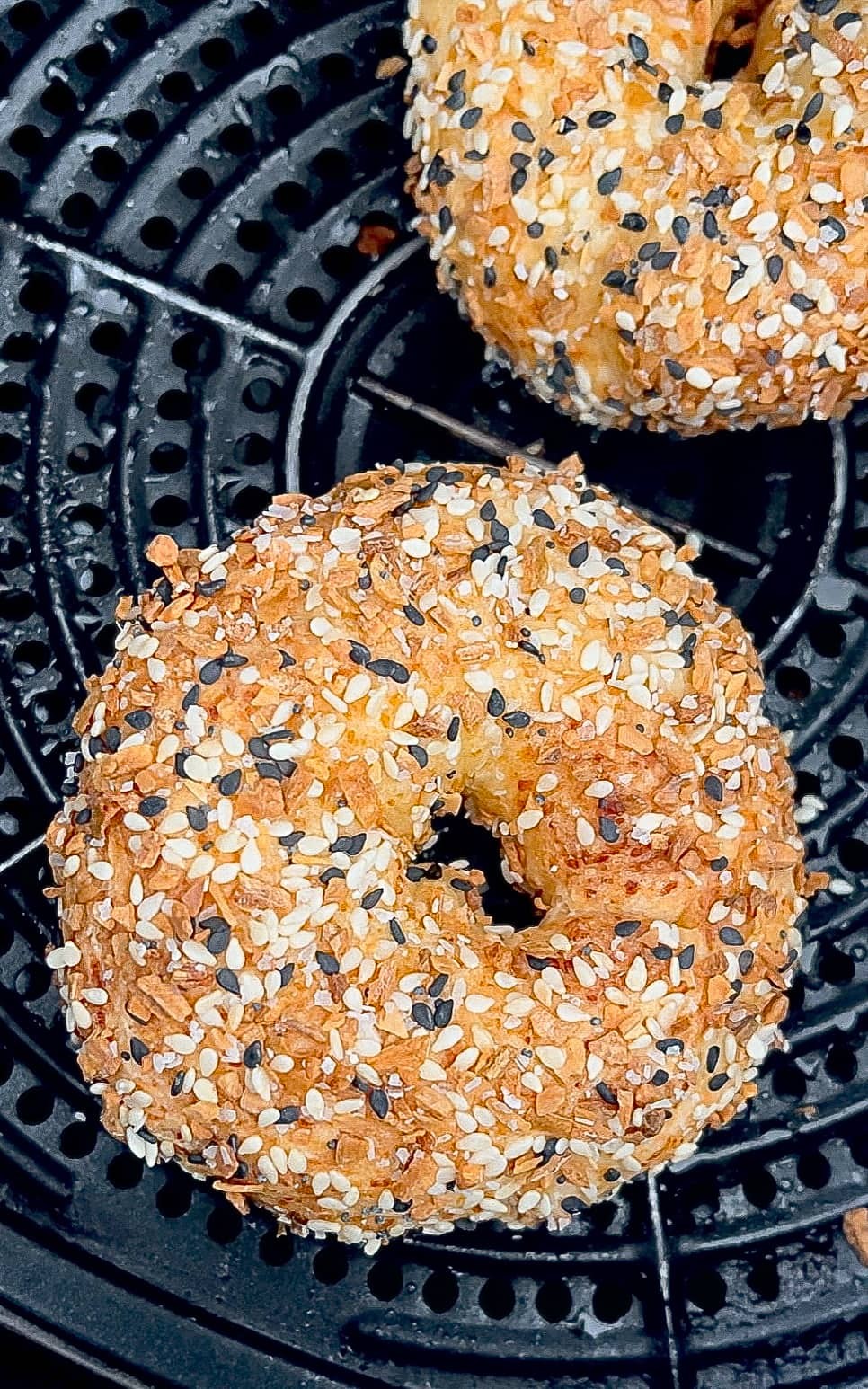How much protein is in a bagel? The answer depends on the bagel, but understanding the protein content is essential for balancing your diet, and HOW.EDU.VN is here to help. In general, a plain bagel offers a modest amount of protein. For those aiming to boost their protein intake, high-protein bagels packed with seeds, whole grains, or added protein sources can be a smart choice. Let’s delve into the nutritional value of bagels, explore ways to increase their protein content, and discover how they can fit into your health goals, complemented by expert advice on nutritional balance and dietary planning.
1. Understanding the Protein Content of a Standard Bagel
How much protein does a standard bagel offer? The protein content in a standard bagel typically ranges from 8 to 12 grams, depending on size and ingredients.
1.1. Average Protein in Different Types of Bagels
Different types of bagels contain varying levels of protein. The average protein content can be:
- Plain Bagel: Around 9-11 grams
- Whole Wheat Bagel: Approximately 10-12 grams
- Everything Bagel: Roughly 9-11 grams
- Sesame Bagel: About 8-10 grams
These figures are approximate and can vary based on the specific recipe and size of the bagel.
1.2. Factors Affecting Protein Levels in Bagels
Several factors can influence the protein content of a bagel:
- Size: Larger bagels will naturally contain more protein than smaller ones.
- Flour Type: Whole wheat flour generally has more protein than refined white flour.
- Added Ingredients: Some bagels include added ingredients like seeds or nuts, which can boost the protein content.
- Preparation Method: The specific recipe and baking process can slightly affect the final protein levels.
1.3. Comparing Bagel Protein to Other Breakfast Options
How does a bagel’s protein content compare to other common breakfast choices? Here’s a brief overview:
| Breakfast Item | Approximate Protein Content |
|---|---|
| Plain Bagel | 9-11 grams |
| Greek Yogurt (1 cup) | 20-25 grams |
| Eggs (2 large) | 12-14 grams |
| Oatmeal (1 cup) | 5-7 grams |
| Toast (2 slices) | 4-6 grams |



As you can see, bagels offer a moderate amount of protein compared to options like Greek yogurt or eggs, but more than oatmeal or toast.
2. The Importance of Protein in Your Diet
Why is protein such a crucial component of a balanced diet? Protein plays multiple vital roles in maintaining health and well-being.
2.1. Key Roles of Protein in the Body
Protein is essential for:
- Muscle Building and Repair: Protein provides the amino acids needed to build and repair muscle tissue, making it crucial for athletes and those engaging in regular physical activity.
- Enzyme and Hormone Production: Many enzymes and hormones, which regulate various bodily functions, are made of protein.
- Immune Function: Antibodies, which help fight off infections, are proteins.
- Tissue Repair: Protein aids in repairing damaged tissues, promoting faster recovery from injuries.
- Satiety: Protein helps you feel fuller for longer, which can aid in weight management by reducing overall calorie intake.
2.2. Recommended Daily Protein Intake
What is the recommended daily protein intake? The general guideline is around 0.8 grams of protein per kilogram of body weight. However, this can vary based on factors like activity level, age, and overall health.
- Sedentary Adults: 0.8 grams per kilogram
- Active Individuals: 1.2-1.7 grams per kilogram
- Athletes: 1.5-2.0 grams per kilogram
For example, a 150-pound (68 kg) sedentary adult would need around 54 grams of protein per day, while an athlete might need 102-136 grams.
2.3. Benefits of Adequate Protein Consumption
Consuming enough protein offers several benefits:
- Improved Muscle Mass: Adequate protein intake supports muscle growth and maintenance, crucial for strength and metabolism.
- Enhanced Weight Management: Protein’s satiety effect helps control appetite and reduce overall calorie intake.
- Better Bone Health: Protein is essential for maintaining bone density and reducing the risk of osteoporosis.
- Faster Recovery: Protein aids in repairing tissues, which is particularly important after exercise or injury.
- Increased Energy Levels: Protein helps stabilize blood sugar levels, providing a sustained source of energy throughout the day.
3. Enhancing the Protein Content of Your Bagel
Want to increase the protein content of your bagel? There are several effective strategies to boost the protein punch of your favorite breakfast item.
3.1. Choosing High-Protein Bagel Varieties
Opting for high-protein bagel varieties is a great first step.
- Whole Wheat Bagels: Naturally contain more protein than white bagels.
- Sprouted Grain Bagels: Offer a higher protein and nutrient content.
- Protein-Enriched Bagels: Some brands add protein isolates or concentrates to boost the protein content significantly.
- Homemade Bagels: Allows you to control the ingredients and add protein-rich components like protein powder or seeds.
3.2. Adding Protein-Rich Spreads and Toppings
Selecting the right spreads and toppings can significantly increase the protein content of your bagel.
- Greek Yogurt: A single serving can add 20-25 grams of protein.
- Cottage Cheese: Provides about 12 grams of protein per half-cup serving.
- Nut Butters: Almond, peanut, or cashew butter can add 7-8 grams of protein per serving.
- Hummus: Offers around 2-3 grams of protein per serving, along with fiber and healthy fats.
- Smoked Salmon: Provides a substantial amount of protein, along with omega-3 fatty acids.
- Eggs: Adding a fried or scrambled egg can boost the protein content by 6-7 grams per egg.
3.3. Creative High-Protein Bagel Recipes
Get creative with your bagel recipes to maximize their protein content:
- Breakfast Bagel Sandwich: Combine eggs, cheese, and lean meat like turkey or ham for a protein-packed breakfast.
- Lox and Cottage Cheese Bagel: Top a bagel with smoked salmon and cottage cheese for a delicious and protein-rich meal.
- Nut Butter and Banana Bagel: Spread almond butter on a bagel and add sliced banana for a balanced breakfast with protein and healthy carbs.
- Hummus and Veggie Bagel: Add hummus, sliced cucumbers, tomatoes, and spinach for a vegetarian option that’s high in protein and fiber.
- Protein Bagel Pizza: Use a bagel as the base for a pizza, adding tomato sauce, cheese, and protein-rich toppings like pepperoni or grilled chicken.
4. The Role of Bagels in a Balanced Diet
How can bagels fit into a balanced diet? Bagels can be part of a healthy eating plan when consumed mindfully and paired with nutritious toppings.
4.1. Nutritional Benefits of Bagels
Bagels offer several nutritional benefits:
- Carbohydrates: Provide energy for daily activities and physical exercise.
- Fiber: Whole wheat bagels are a good source of fiber, promoting digestive health and satiety.
- Vitamins and Minerals: Some bagels are enriched with vitamins and minerals like iron and B vitamins.
- Versatility: Bagels can be paired with a variety of toppings to create balanced and satisfying meals.
4.2. Potential Drawbacks of Overconsumption
However, there are also potential drawbacks to overconsuming bagels:
- High Calorie Content: Bagels can be calorie-dense, especially larger ones or those with added sugars and fats.
- Refined Carbohydrates: White bagels are primarily made of refined carbohydrates, which can lead to blood sugar spikes and energy crashes.
- Sodium Content: Some bagels can be high in sodium, which can be a concern for individuals with high blood pressure.
- Glycemic Index: Bagels have a relatively high glycemic index, which means they can cause a rapid increase in blood sugar levels.
4.3. Balancing Bagels with Other Food Groups
To make bagels a part of a balanced diet, pair them with foods from other food groups:
- Protein: Add protein-rich toppings like Greek yogurt, cottage cheese, eggs, or lean meats.
- Healthy Fats: Include healthy fats like avocado, nut butter, or olive oil-based spreads.
- Fruits and Vegetables: Add fresh fruits or vegetables for added vitamins, minerals, and fiber.
- Whole Grains: Opt for whole wheat or sprouted grain bagels for increased fiber and nutrients.
4.4. Sample Balanced Bagel Meal Plans
Here are a few sample balanced bagel meal plans:
- Breakfast: Whole wheat bagel with Greek yogurt, berries, and a sprinkle of chia seeds.
- Lunch: Everything bagel with hummus, sliced cucumbers, tomatoes, and spinach.
- Snack: Plain bagel with almond butter and sliced banana.
5. Making Your Own High-Protein Bagels
Want even more control over the protein content? Making your own high-protein bagels is a great option.
5.1. Basic Ingredients for Homemade Bagels
Here are the basic ingredients you’ll need:
- Flour: All-purpose or whole wheat flour
- Water: Warm water for activating the yeast
- Yeast: Active dry yeast
- Salt: For flavor and to control yeast activity
- Sugar or Honey: To feed the yeast
- Optional: Malt syrup or barley malt extract for a traditional bagel flavor
5.2. Adding Protein to Your Bagel Dough
To boost the protein content, consider adding these ingredients:
- Protein Powder: Whey, casein, or plant-based protein powder
- Greek Yogurt: Adds moisture and protein
- Cottage Cheese: Provides a creamy texture and extra protein
- Seeds: Chia, flax, or sunflower seeds for added protein and nutrients
- Oat Flour: Adds fiber and protein
- Vital Wheat Gluten: Improves the texture and protein content of the dough
5.3. Step-by-Step Guide to Baking High-Protein Bagels
Here’s a step-by-step guide to baking your own high-protein bagels:
- Activate the Yeast: In a small bowl, combine warm water with sugar or honey and yeast. Let it sit for 5-10 minutes until foamy.
- Combine Dry Ingredients: In a large bowl, mix flour, salt, and any protein-boosting ingredients like protein powder or seeds.
- Add Wet Ingredients: Add the yeast mixture and Greek yogurt or cottage cheese (if using) to the dry ingredients. Mix until a shaggy dough forms.
- Knead the Dough: Turn the dough out onto a lightly floured surface and knead for 5-10 minutes until smooth and elastic.
- First Rise: Place the dough in a lightly oiled bowl, cover, and let it rise in a warm place for about an hour, or until doubled in size.
- Shape the Bagels: Punch down the dough and divide it into equal portions (usually 6-8 bagels). Roll each portion into a rope and join the ends to form a bagel shape.
- Second Rise: Place the shaped bagels on a baking sheet lined with parchment paper, cover, and let them rise for another 30 minutes.
- Boil the Bagels: Bring a large pot of water to a boil. Add malt syrup or barley malt extract (if using). Gently drop the bagels into the boiling water, 1-2 at a time. Boil for 1-2 minutes per side.
- Bake the Bagels: Remove the bagels from the water and place them back on the baking sheet. Brush with egg wash and sprinkle with your choice of toppings like sesame seeds, poppy seeds, or everything bagel seasoning.
- Bake: Preheat oven to 425°F (220°C). Bake for 20-25 minutes, or until golden brown.
- Cool: Let the bagels cool on a wire rack before slicing and enjoying.
5.4. Tips for Perfect Homemade Protein Bagels
Here are some tips for making the best homemade protein bagels:
- Use Fresh Yeast: Ensure your yeast is fresh for the best rise.
- Don’t Overknead: Overkneading can result in tough bagels.
- Boil Before Baking: Boiling the bagels is crucial for achieving that chewy texture.
- Experiment with Flavors: Try different protein powders, seeds, and toppings to create your favorite flavor combinations.
- Store Properly: Store bagels in an airtight container to maintain freshness.
6. Case Studies: High-Protein Bagels in Action
Let’s explore how high-protein bagels can be incorporated into different lifestyles and dietary needs.
6.1. Case Study 1: Athlete’s Pre-Workout Meal
Scenario: A marathon runner needs a high-protein, high-carb meal before a morning training session.
Solution: A whole wheat bagel with almond butter, sliced banana, and a sprinkle of chia seeds.
- Protein: Provides sustained energy and supports muscle function.
- Carbohydrates: Fuel the workout.
- Healthy Fats: Offer additional energy and support overall health.
6.2. Case Study 2: Weight Management Breakfast
Scenario: An individual aiming to lose weight needs a breakfast that promotes satiety and controls calorie intake.
Solution: A protein-enriched bagel with Greek yogurt, berries, and a sprinkle of flaxseeds.
- Protein: Helps reduce appetite and control cravings.
- Fiber: Promotes digestive health and keeps you feeling full.
- Low Calorie: Keeps the overall calorie count in check.
6.3. Case Study 3: Vegetarian Protein Boost
Scenario: A vegetarian looking to increase their protein intake.
Solution: An everything bagel with hummus, sliced cucumbers, tomatoes, and spinach.
- Protein: Provides a plant-based source of protein.
- Fiber: Aids digestion and promotes satiety.
- Vitamins and Minerals: Offers essential nutrients from vegetables.
7. Expert Opinions on Protein and Bagels
What do nutrition experts say about incorporating bagels and protein into your diet?
7.1. Quotes from Registered Dietitians
- “Bagels can be a part of a balanced diet when paired with nutritious toppings and consumed in moderation. Opt for whole wheat bagels to increase fiber intake, and add protein-rich toppings like Greek yogurt, eggs, or nut butter to boost satiety and support muscle health.” – Dr. Emily Carter, Registered Dietitian at HOW.EDU.VN
- “Increasing your protein intake can have numerous benefits, from weight management to muscle growth. Bagels alone may not provide enough protein, but adding protein-rich toppings or making your own high-protein bagels can make them a valuable part of your diet.” – Dr. Sarah Johnson, Nutrition Specialist at HOW.EDU.VN
7.2. Research Studies on Protein and Satiety
Several studies support the benefits of protein for satiety and weight management:
- A study published in the American Journal of Clinical Nutrition found that higher protein diets led to greater satiety and reduced calorie intake compared to lower protein diets.
- Research in the Journal of Nutrition showed that consuming protein-rich breakfasts can help control appetite and improve blood sugar levels throughout the day.
7.3. Recommendations from Nutrition Professionals
Nutrition professionals recommend:
- Choosing whole grain or sprouted grain bagels over white bagels.
- Pairing bagels with protein-rich and fiber-rich toppings.
- Monitoring portion sizes to avoid overconsumption.
- Incorporating a variety of protein sources into your diet, not just relying on bagels.
8. Frequently Asked Questions (FAQ) About Protein and Bagels
Have more questions about protein and bagels? Here are some frequently asked questions:
8.1. How many grams of protein are in a plain bagel?
A plain bagel typically contains about 9-11 grams of protein.
8.2. Are whole wheat bagels higher in protein?
Yes, whole wheat bagels generally contain slightly more protein than plain bagels, usually around 10-12 grams.
8.3. Can I add protein powder to bagel dough?
Yes, adding protein powder to bagel dough is a great way to increase the protein content.
8.4. What are some high-protein toppings for bagels?
High-protein toppings include Greek yogurt, cottage cheese, nut butter, eggs, and smoked salmon.
8.5. How can I make my own high-protein bagels?
You can make high-protein bagels by adding protein powder, Greek yogurt, cottage cheese, or seeds to the dough.
8.6. Is it healthy to eat a bagel every day?
Eating a bagel every day can be part of a healthy diet if you choose whole grain varieties and pair them with nutritious toppings.
8.7. How do bagels compare to other breakfast foods in terms of protein?
Bagels offer a moderate amount of protein compared to options like Greek yogurt or eggs but more than oatmeal or toast.
8.8. What is the best time to eat a protein bagel?
A protein bagel can be a great pre-workout meal for sustained energy or a post-workout meal for muscle recovery.
8.9. Are bagels a good source of fiber?
Whole wheat bagels are a good source of fiber, promoting digestive health and satiety.
8.10. Can high-protein bagels help with weight loss?
High-protein bagels can aid in weight loss by promoting satiety and reducing overall calorie intake when part of a balanced diet.
9. Conclusion: Maximizing Protein Intake with Bagels
Bagels can be a versatile and satisfying part of your diet, especially when you focus on maximizing their protein content. By choosing high-protein varieties, adding nutritious toppings, or even making your own protein-packed bagels, you can enjoy this classic food while meeting your dietary needs. For personalized advice and comprehensive nutritional support, consult with the experts at HOW.EDU.VN.
Understanding how much protein is in a bagel and how to enhance its protein content is essential for optimizing your nutrition. Whether you’re an athlete, aiming for weight management, or simply looking to boost your protein intake, bagels can be a valuable addition to your meal plan. By making informed choices and pairing bagels with other nutritious foods, you can enjoy their benefits as part of a balanced and healthy lifestyle.
Are you seeking personalized advice on incorporating high-protein bagels into your diet or have specific nutritional concerns? At HOW.EDU.VN, we connect you with leading experts who can provide tailored recommendations and support to help you achieve your health goals.
Take the Next Step: Contact our team of PhDs at HOW.EDU.VN today. Our experts can help you create a customized meal plan that incorporates high-protein bagels and other nutritious foods to support your overall health and wellness.
Address: 456 Expertise Plaza, Consult City, CA 90210, United States
WhatsApp: +1 (310) 555-1212
Website: HOW.EDU.VN
Let how.edu.vn be your guide to a healthier, more informed lifestyle. Connect with our experts today and start your journey toward optimal nutrition and well-being.
